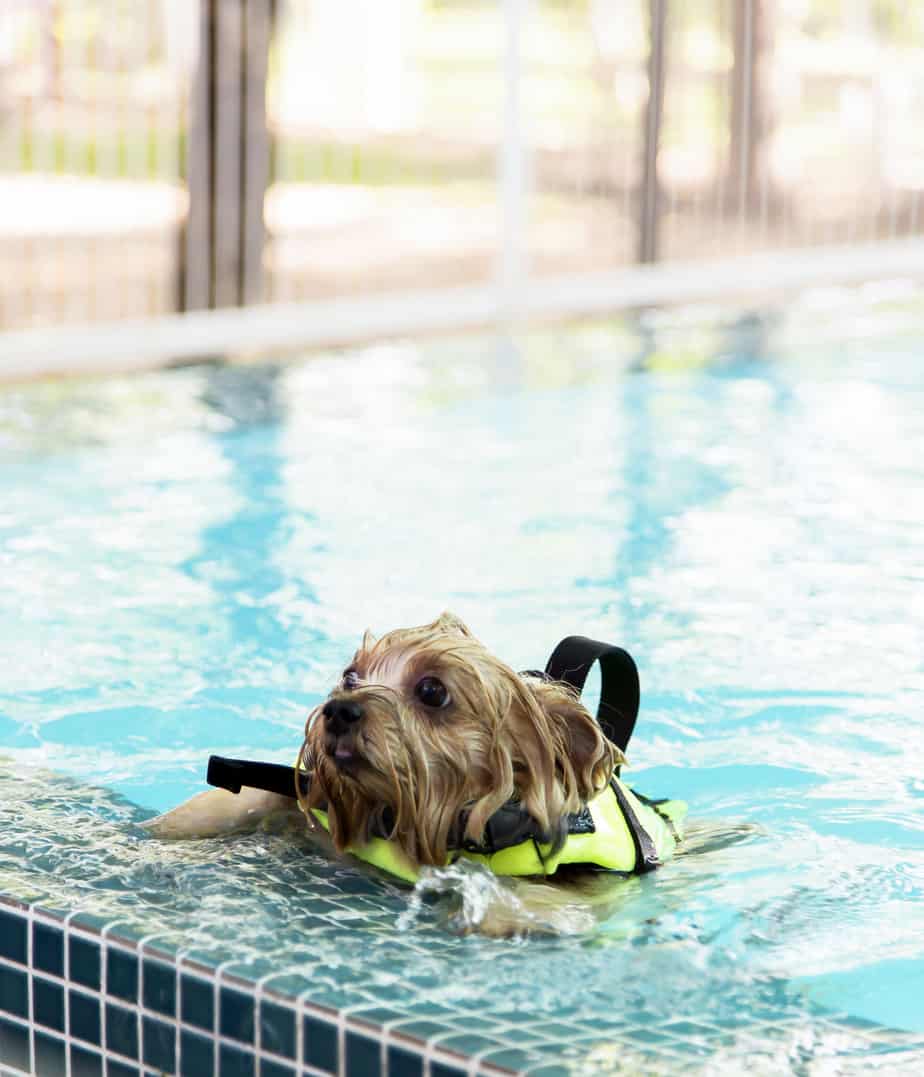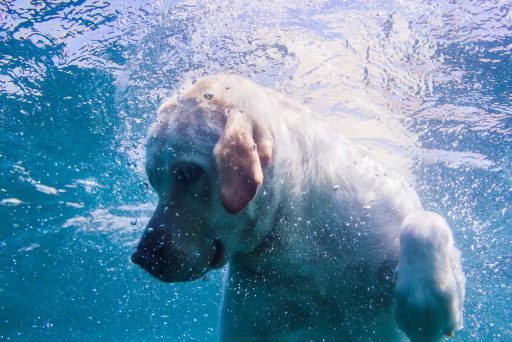Some dogs love to swim. Indeed it seems that some prefer water to land. They can smell the lake, creek, or pool calling to them from a mile away! You mostly see dogs swimming on the surface of water, but can they dive and swim underwater?
Can dogs swim under water? Yes, most dogs can swim underwater. Some dogs love to swim underwater, and take to it very naturally.
Can dogs hold their breath underwater?
Dogs have the natural ability to hold their breath when underwater. It isn’t really known how long a dog can hold its breath, just that they can hold their breath when needed.
In addition to a dog holding his breath, his body goes through other automatic changes when diving. His heart rate will slow and his blood vessels will narrow, both these processes will help your dog to conserve oxygen.
Which Dog Breeds like to Swim Underwater?
There are lots of breeds that can dive. Dogs bred to retrieve a hunter’s fallen prey or save overboard shipmates are among some of the dog world’s best swimmers. There are even some breeds that have webbed feet! This helps them to swim even better.
There are a couple of dogs near Boca Inlet that have been trained to retrieve lobsters from the seafloor. These two labs can dive as deep as 15 feet to catch a lobster.
There is a report of another dog named, Bunny, who dives up to 13 feet to get a toy. Bunny is also a Labrador Retriever.
Yup, you guessed it Labrador Retrievers are one of these webbed feet breeds. Bred to retrieve fallen birds from all sorts of environments including marshes, fields, lakes, and rivers.
Labrador Retrievers aren’t the only breed that love water, here are a few other breeds that love swimming in and under water too.
1. The Newfoundland is another webbed foot breed. These giant dogs are often used to save people from freezing waters. They are huge, strong, and have a waterproof coat that helps keep them warm in freezing waters.
2. Portuguese Water Dogs are another breed with webbed feet. This breed was bred to “herd” schools of fish toward fishing nets. They also would deliver messages between fishing boats.

A Portugese Water Dog ready to dive into the water
3. The American Water Spaniel was bred to retrieve birds that were shoot by hunters. These spaniels retrieve the birds from where ever they fall, including water! They also have webbed feet.
4. Otterhounds are another breed with webbed feet. As the name implies, the Otterhound was bred to hunt otters in medieval England.
5. The German Short Hair Pointer and German Wirehair Pointer are both breeds with webbed feet. These breeds are both bred to sniff out, point out, and then fetch the prey of hunters. They are efficient workers on all terrain.
6. Wimerhiners likewise have webbed feet. They are capable hunters in and out of the water.
7. Chesapeake Bay Retrievers were bred to swim and retrieve in the chilly waters of the Chesapeake Bay. They have a super warm double coat, webbed feet, and are tireless retrievers.
8. The Nova Scotia Duck Tolling Retriever has significant webbing between its toes. This breed is particularly good for retrieving fallen ducks and even lures waterfowl closer to hunters.
9. The Irish Water Spaniel, too, has webbed feet. This breed is an excellent swimmer and is well suited to retrieve in the water and on land.
10. Poodles are another breed bred to retrieve fallen waterfowl. They have webbed feet to enhance their swimming capabilities.
The Golden Retriever, too, has webbed feet. Bred to retrieve from land or water. It’s hard to find a Golden how doesn’t love water.
But any dog who likes water and can swim well may enjoy diving. Even some toy breeds can dive, such as the Cavalier King Charles Spaniel. It all depends on the dog, his desire to and his ability to swim.
What Are the Health Benefits Of Swimming For Dogs?
There are lots of health benefits associated with swimming for dogs. It’s a great low impact way for them to get exercise. This means that swimming is great for dogs of all ages, even those with joint issues or those who need to lose some weight.
Swimming is great exercise for dogs and most of them enjoy playing in the water. Play and exercise are wonderful for your dog’s health and yours too! Because swimming is such good exercise it is also very tiring for your dog. This is a good thing. I tired dog is a well-behaved dog.

Swimming provides both mental and physical stimulation. This is important for all dogs. If you add diving to the mix this provides even more stimulation!
Swimming is also a good way to cool your dog down on a hot day. Especially, if your dog immerses himself in the water by diving down into it!
Swimming in warm water can provide pain relief to some dogs. Finding a warm spot to swim can be a little challenging though.
If your dog likes swimming under water, then diving provides special benefits like being great for your dog’s lungs. If your dog has to hold his breath to dive, then he increases his lung efficiency and capacity. This can help your dog when partaking in other physical activities.
What Precautions Should You take when you take your dog swimming?
Not all dogs can swim. Be sure to check to make sure your dog can swim and likes to swim before sending your dog diving.
Swimming can be very tiring for some dogs, so be sure to introduce swimming slowly so your dog can build the muscles required to swim. It’s also a good idea to provide a life jacket for your dog if you think he may need one. Of course, a life jacket will very much hinder diving. But it’s nice for a dog who is just going for a swim or just getting started with swimming. Here are a few other tips when taking your dog swimming, especially if he likes swimming under water.
1. Always be sure to check the water temperature before allowing your dog to go for a swim. Dogs can suffer from hypothermia just like people. So, be sure the water is not too cold.
2. Before encouraging your dog to dive or jump into the water make sure that the water is deep enough. If it is not very deep your dog may be injured upon jumping in.
3. Where ever you are letting your dog swim be sure to bring along plenty of clean fresh water for him to drink. Then he won’t be tempted to drink any pool water, salt water, or potentially parisite ridden water.
4. It is also a good idea to hose your dog off after swimming. This will help to remove any chemicals, salt, or parasites from your dog’s skin and coat. It might be good to follow that with a bath and use a nice moisturizing shampoo. Or a good brushing to help stimulate the dog’s skin to create healthy oils and then spread that oil throughout the fur.
5. You may also want to give your dog a couple of eye drops after swimming. Use a simple saline solution. This will help to flush out any chemicals or salt and soothe the eyes if they are irritated.
6. Some dogs such as Springer Spaniels may be more likely to develop an ear infection after swimming. This is usually due to water in the ear. So, cleaning your dog’s ears after swimming or diving is a good plan. You can use a solution of half apple cider vinegar and half filtered water. This will help to dry out any dampness in the ear. You can use a cotton ball (never cotton swabs!) to gently dry the ear as well.
Is it Ok For Your Dog To Swim Underwater In a swimming Pool?
If your dog swims in your pool, keep in mind that chlorine can damage your dog’s skin, ears, and eyes. This is because dogs can be more sensitive to chemicals than humans. It’s a good idea not to overdo it with the chlorine (if it’s your pool) and remember to wash your dog with clean fresh water after he’s finished playing in the pool. This will help to remove any harmful chemicals.
When a dog swims in your pool, he may also bring in lots of things you may not want in your pool. It is said that one dog is like having three people in your pool, because of all the contaminates they can bring in!
Be sure that your dog has an easy way to get out of the pool as well. Teach your dog how to exit the pool even if he hates water. This is a great precaution. You never know if your dog might fall into the pool. If he does he should know how to get out.
Are Fresh Water bodies safe for dogs?
Lakes, rivers, and other natural freshwater bodies pose other issues. They may contain parasites, bacteria, or harmful algae. Some lakes are also treated with chemicals to reduce algae growth. Dogs are not usually affected by these things too much. However, each dog is different so it’s good to be informed.
If your dog is swimming at a natural body of water keep an eye out for fishing gear. Your dog could easily become tangled in discarded fishing line. Your dog may get a fishing hook caught on or in them somewhere, so it’s a good idea to keep a first aid kit handy.
Is it ok to let your dog Swim in saltwater?
If you are letting your dog swim or dive in saltwater be aware that the salt can burn his eyes and cause irritation. It is also important to note that you should not let your dog drink salt water. This can cause salt toxicity and make your dog very sick.
Can a dog drown in the ocean?
Yes, a dog can drown in the ocean. In fact, many dogs drown or suffer from near drowning every year. Be aware of rip tides when swimming at the ocean as well. These can rip your dog’s feet right out from under him and carry him away from shore. This can be a very dangerous situation, so be aware and be safe.
Keep an eye out for fishing gear at the beach. Be on the lookout for other things that have been washed up on the beach that could pose a threat to your dog. This could include jellyfish, broken glass, fish, and a myriad of other things.
How To Train Your Dog To Swim Underwater
First, make sure your dog likes water. If your dog is not a water lover it is best not to force them into water. This will only increase the dog’s fear and damage the dog’s bond with you.
When introducing your dog to water and swimming for the first time, you might want to let your dog were a life jacket. This will help support them as they learn and get comfortable swimming.
Be sure to make swimming a very positive experience. Use toys, games, praise, and/or treats to make the water fun for your dog. Of course, if you are in the water too this makes the water much more appealing.
When training your dog to dive start in water that is easy to see through. You are going to be using a toy to lure your dog to dive. So, the water needs to be clear enough for him so see the toy. A pool might be the best place to start.
To start getting your dog used to diving you need a toy that will sink in water. Start by playing with the toy with your dog on land. make the toy super interesting and exciting for your dog.
Next, toss the, now epic, toy into the shallows of the water. Encourage your dog to go after the toy. Give him mega praise and a tasty treat when he comes out of the water. After doing this a few times it’s a good idea to let your dog rest and do some more work tomorrow.
On your next training session make the toy super exciting again. Then get in the water. Hold the toy just below the surface of the water. Encourage your dog to take it from you. When he does, big praise and a treat! Always let the dog have the toy. If he never gets the toy he will stop trying to. Continue in this manner, slowly lowering the toy each time.
Proceed until your dog can go all the way to the bottom of the pool! This may take several training sessions. For best results always stop before your dog wants to stop. This will keep him eager for the next session.
Eventually, you will get to point where you can toss the toy into the water from land and your dog will dive in after it. As your dog gains confidence and enjoys the game more you can fade out the use of treats. But it’s always a good idea to praise him.
Summary – Can Dogs swim underwater?
Dogs can swim underwater, and dogs can also dive under water – not as well as a penguin or a fish of course! Just about any dog can dive if they have the right motivation, but not all dogs enjoy diving or swimming. Having a dog that enjoys diving can be great fun for both of your, plus great exercise for your dog!
Sources
https://www.cuteness.com/13715408/can-dogs-hold-their-breath
https://www.petmd.com/dog/slideshows/breeds/top-swimming-dog-breeds
https://www.local10.com/pets/2016/02/22/dogs-trained-to-dive-for-lobsters/
https://www.dailydogstuff.com/dogs-with-webbed-feet/
https://www.rover.com/blog/dogs-webbed-feet-swimmer-dog-breeds/





